Basic Procedure for Copying Documents
Set the original on the exposure glass or auto document feeder (ADF) to make a copy.

If the previous setting is still active, press [Reset] before copying.
 Press [Copy] on the Home screen.
Press [Copy] on the Home screen.
 Place the original.
Place the original.
Placing an Original on the Exposure Glass
Placing an Original in the Auto Document Feeder (ADF)
To copy both sides of the paper, to staple, or to punch holes, confirm the orientation of the original according to how you want the printout to appear.
Basic Original Orientation
Place | Orientation | |
|---|---|---|
Exposure Glass | Place the original face down in a readable orientation. | 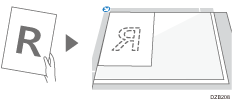 |
ADF | Place the original face up in a readable orientation. | 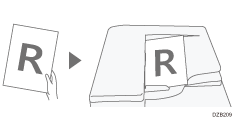 |
If the Readable Orientation Is Not Vertical
When you copy a portrait original larger than A4 or 8 1/2" × 11" (LT) (A3 or 11" × 17"), place it as shown below, and then specify [Original Orientation].
Place | Orientation | |
|---|---|---|
Exposure Glass | Rotate the original clockwise or counter-clockwise 90 degrees and place it face down. | 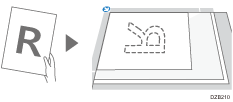 |
ADF | Rotate the original clockwise or counter-clockwise 90 degrees and place it face up. | 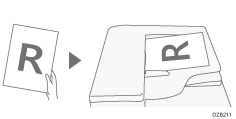 |
When Specifying [Top 2] as the Staple or Punch Position
Place an original as shown below, and then specify [Original Orientation].
Place | Orientation | |
|---|---|---|
Exposure glass | Place the original face down in a readable orientation. |  |
Auto document feeder (ADF) | Place the original face up in a readable orientation. |  |
 Press [Original Orientation] on the Copy screen.
Press [Original Orientation] on the Copy screen.

If the key is not displayed, select it from [Original Settings].
When you place the original face up in a readable orientation, this setting is not necessary if [Readable Direction] is displayed on the key. Placing of the original is completed.
 Specify the Original Orientation.
Specify the Original Orientation.
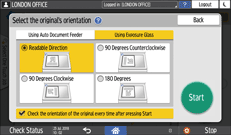
If the display of this screen is not necessary when you press [Start], clear the [Check the orientation of the original every time after pressing [Start]] check box.
Placing of the original is completed.
 Press [
Press [ ] or [
] or [ ] in [Quantity] to specify the number of copies.
] in [Quantity] to specify the number of copies.

You can enter this using the keyboard after pressing [Quantity] or a number.
 Press the paper tray select key and select the paper to use as necessary.
Press the paper tray select key and select the paper to use as necessary.

When you select [Auto Paper Select], the paper suitable for the original is selected automatically. When the orientations of the original and paper in the paper tray do not match, the machine rotates the copied image 90 degrees automatically. However, the copied image may not be rotated depending on the settings or types of Finishing, staple or punch, for example.
If the size of the original is not detected properly or when you make a copy on paper of a special size, specify the paper tray in which the paper to use is loaded.
 Press [Start].
Press [Start].
When the [Check the orientation of the original every time after pressing [Start]] check box is selected in [Select the original's orientation], and some settings, such as duplex copying or combining are specified, the screen below is displayed. Select the original orientation as necessary. If you do not need to select this each time, clear the check box.
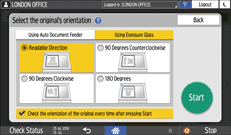
When you place the original on the ADF, the process of copying the original starts.
When you place the original on the exposure glass, the copy process starts according to the setting contents. To make a copy of the second page or back side of the original, place the original accordingly on the exposure glass, and then press [Start]. Press [Finish Scn] after scanning all originals if necessary according to the setting contents.

Originals scanned when no paper is loaded or when an error has occurred will be copied automatically when the machine is ready to execute copying.
Reserving a Copy Job While Executing Another Copy Job
When [Reserve] is displayed on the execution screen of the current copy job, you can scan the original of another copy job to execute after the current job is completed (Job Preset).
You can make reservations for up to eight jobs each in the Copier and Document Server functions.
 Press [Reserve] on the execution screen of a copy job.
Press [Reserve] on the execution screen of a copy job.
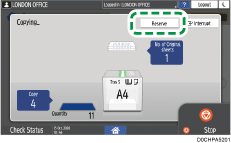
 Place a new original to scan on the machine.
Place a new original to scan on the machine.
 Specify 2 sided, Combine, Sort, and other copy settings if necessary.
Specify 2 sided, Combine, Sort, and other copy settings if necessary.
Combining and Copying a Multi-page Original onto a Single Sheet of Paper
 Press [ReserveStart].
Press [ReserveStart].
The machine starts scanning the placed original.
After the current copy job is completed, the reserved copy job starts automatically.

To delete the reserved job or preview its image on the screen, press [Job Confirmation].
Interrupting the Current Copy to Copy Another Original
When [Interrupt] is displayed on the copy processing screen, you can pause the current copy to scan and copy another original (Interrupt mode).
 Press [Interrupt] on the execution screen of a copy job.
Press [Interrupt] on the execution screen of a copy job.
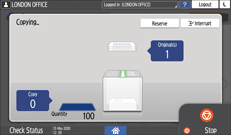
 When the scanning stops, remove the original being copied.
When the scanning stops, remove the original being copied.
 Place a new original to scan on the machine.
Place a new original to scan on the machine.
 Specify 2 sided, Combine, Sort, and other copy settings if necessary.
Specify 2 sided, Combine, Sort, and other copy settings if necessary.
Combining and Copying a Multi-page Original onto a Single Sheet of Paper
 Press [InterruptStart].
Press [InterruptStart].
 When the Interrupt mode is finished, remove the original and copied paper.
When the Interrupt mode is finished, remove the original and copied paper.
 Press [Cancel Interrupt].
Press [Cancel Interrupt].
 Set the rest of the original that was supposed to be copied before the Interrupt mode, and press [Start].
Set the rest of the original that was supposed to be copied before the Interrupt mode, and press [Start].
The previous copy job settings are restored. Simply press [Start] to continue copying from where it left off.

You cannot use the Interrupt mode while scanning a fax original.
You cannot use the Interrupt mode with the staple mode while copying in the staple mode.
